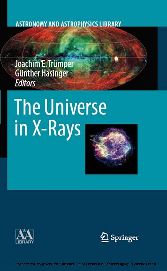Suchen und Finden
Preface
5
Contents
7
1 Overview
21
2 Proportional Counters
23
2.1 Introduction
23
2.2 Gaseous Detectors
23
2.3 Operation Principle of a Proportional Counter
24
2.4 Large Area Proportional Counters for X-Ray Astronomy
28
2.5 Gas Scintillation Proportional Counters
29
References
31
3 Scintillation Counters
33
3.1 Introduction
33
3.2 Scintillation Counters for X-Ray Astronomy
34
References
37
4 Imaging Proportional Counters
38
4.1 Introduction
38
4.2 Geometry of Multiwire Proportional Counters
38
4.3 Position Resolution of Multiwire Proportional Counters
39
4.4 Position Readout Methods
40
4.5 The ROSAT PSPC
42
4.6 Imaging Gas Scintillation Proportional Counters
43
References
45
5 Aperture Modulation Telescopes
46
5.1 Principle of Aperture Modulation
46
5.2 Various Coded-Mask Telescope Missions
54
References
56
6 Wolter Optics
57
6.1 Principle
57
6.2 Wolter-Type Telescopes
59
6.3 General Imaging Properties
61
6.4 Nesting of Mirror Shells
63
6.5 Fabrication Techniques for Wolter Telescopes
64
6.6 Missions with Wolter Telescopes
65
References
66
7 CCD Detectors
67
7.1 Introduction
67
7.2 MOS CCDs
68
7.3 Fully Depleted Back-Illuminated pnCCDs
68
7.4 New Detector Developments: Active Pixel Sensors for X-Rays
84
7.5 Conclusion
86
References
87
8 High Resolution Spectroscopy
88
8.1 Introduction
88
8.2 Transmission Gratings
88
8.3 Chandra
92
8.4 Re.ection Gratings: XMM-Newton RGS
94
8.5 Bolometers
97
References
97
9 Solar System Objects
99
9.1 Introduction
99
9.2 Solar X-Rays
100
9.3 Solar Wind
101
9.4 What do We Learn from the X-Ray Observations?
108
References
109
10 Nuclear Burning Stars
111
10.1 The Sun, Stars, and Stellar X-Ray Astronomy
111
10.2 Cool Stars On and Off the Main-Sequence
120
10.3 Very Low-Mass Stars and Brown Dwarfs
128
10.4 Premain Sequence Stars
132
10.5 Stellar Wind Sources
140
10.6 Stars with Magnetic Winds
142
References
144
11 White Dwarfs
146
11.1 Introduction
146
11.2 Discovery of X-Rays from White Dwarfs
146
11.3 ROSAT
148
11.4 X-Ray Spectroscopy with EUVE, Chandra, and XMM-Newton
150
11.5 Hydrogen-Deficient White Dwarfs
152
References
155
12 X-Ray Emission of Cataclysmic Variables and Related Objects
157
12.1 Historical Introduction
157
12.2 The Zoo of CVs
158
12.3 Accretion Geometries
159
12.4 X-Ray and EUV Emission from Nonmagnetic CVs
162
12.5 X-Rays from Intermediate Polars
163
12.6 X-Rays from Polars
166
12.7 Accretion Rates
169
12.8 Novae and Close-Binary Supersoft Sources (CBSS)
172
References
178
13 Classical Novae
181
13.1 Introduction
181
13.2 Sources of X-Rays
182
13.3 EXOSAT: A Rather Noisy Beginning
183
13.4 ROSAT: Basic Properties
184
13.5 Chandra and XMM: High Resolution and New Surprises
188
13.6 Concluding Remarks
193
References
194
14 Pulsars and Isolated Neutron Stars
195
14.1 Introduction: Historical Overview
195
14.2 Physics and Astrophysics of Isolated Neutron Stars
197
14.3 High-Energy Emission Properties of Neutron Stars
204
References
225
15 Accreting Neutron Stars
229
15.1 Introduction
229
15.2 Overview
230
15.3 High Mass X-ray Binaries: HMXB
234
15.4 Low Mass X-ray Binaries: LMXB
234
15.5 Strongly Magnetized Neutron Stars
235
15.6 Weakly Magnetized Neutron Stars
240
15.7 Summary
247
References
247
16 Black-Hole Binaries
249
16.1 Introduction
249
16.2 X-Ray Binaries
250
16.3 Black Holes Identi.ed from Mass Functions
251
16.4 X-Ray Properties
252
16.5 Quasiperiodic Oscillations
268
16.6 Ultraluminous X-Ray Sources
269
References
270
17 X-Ray Studies of Supernovae and Supernova Remnants
272
17.1 Introduction
272
17.2 Young SNRs
276
17.3 Evolved SNRs
300
17.4 Extragalactic SNRs
306
17.5 X-Ray Supernovae
308
17.6 Conclusion
317
References
317
18 The Interstellar Medium
322
18.1 Introduction
322
18.2 Observations of the Hot Interstellar Medium
325
18.3 Models of the Interstellar Medium
329
18.4 Dust Scattering Halos
335
References
340
19 The Galactic Center
343
19.1 Introduction
343
19.2 Sgr A East and its Environment
348
19.3 Sgr A*
349
19.4 X-Ray Luminous Molecular Clouds
351
References
353
20 X-Rays from Nearby Galaxies
356
20.1 Introduction
356
20.2 History of X-Ray Observations of Galaxies
356
20.3 Point-Like Emission Components
358
20.4 Hot Plasma Components
367
20.5 Future Prospects
372
References
373
21 X-Ray Flares in the Cores of Galaxies
375
21.1 Introduction: Tidal Disruption of Stars by Supermassive Black Holes
375
21.2 X-Ray Flares from Inactive Galaxies
376
21.3 Chandra and XMM-Newton Follow-Up Observations
376
21.4 Future Observations and Applications
379
References
379
22 Active Galactic Nuclei
380
22.1 General Introduction to Active Galaxies
380
22.2 Introduction to Narrow-Line Seyfert 1 Galaxies
386
22.3 The X-ray Slope - Optical Line Widths Relation
387
22.4 XMM-Newton Discoveries in the High-Energy Spectra of NLS1s
393
22.5 The Nature of the Soft X-ray Excess
395
22.6 Matter Under Strong Gravity
396
References
399
23 X-Ray Studies of Clusters of Galaxies
401
23.1 Introduction
401
23.2 Cluster Masses and Composition
404
23.3 Exploration of Cluster Structure
409
23.4 The Virgo Cluster and the Variety of Cluster X-ray Morphology
416
23.5 Cooling and Heating of the ICM
419
23.6 Heavy Element Enrichment of the Cluster ICM
422
23.7 X-Ray Cluster Surveys
427
23.8 Assessing the Cosmic Large-Scale Structure
429
23.9 Cluster Evolution
431
23.10 Testing Cosmological Models
433
23.11 Conclusion and Outlook
435
References
436
24 Gamma-Ray Bursts
441
24.1 The First 30 Years
441
24.2 Major Observational Findings
445
24.3 The Basic Scenarios for Gamma-Ray Burst Emission
452
24.4 Use of GRBs for Cosmology
456
24.5 Outlook: First Results of the Swift Mission
457
References
459
25 Cosmic X-Ray Background
462
25.1 The Early History of the X-Ray Background (XRB)
462
25.2 The ROSAT Deep Surveys
463
25.3 AGN Spectra and Fits to the XRB Spectrum
468
25.4 Deep Surveys with Chandra and XMM-Newton
469
25.5 A Multi-cone Survey AGN-1 Sample
471
25.6 The Soft X-Ray Luminosity Function and Space Density Evolution
473
25.7 X-ray Constraints on the Growth of SMBH
476
25.8 Conclusions
477
References
478
26 The Future
481
26.1 Introduction
481
26.2 Space Agency Strategic Planning
482
26.3 Spektrum–Roentgen–Gamma
483
26.4 The Next Generation Large X-ray Observatory
484
26.5 Conclusions
487
References
487
Appendix: More Information About X-Ray Missions
488
Alle Preise verstehen sich inklusive der gesetzlichen MwSt.








